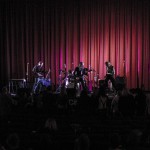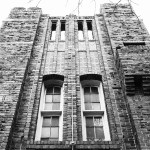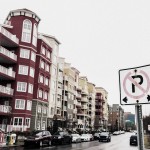Six two-minute talking-head style interviews viewable on the internet, along with links to associated content such as posters, images and various facts and numbers. That was the original plan for Dead Venues, and it seemed simple enough when we began the project: pick six defunct venues that we were familiar with and which are still remembered today; interview a small cross-section of music fans, musicians and promoters; gather info such as opening date, closing date, ownership, square footage, age of building; and put everything together on deadvenues.ca.
But then it all changed very quickly into the production as we saw that we’d struck a collective nerve and were uncovering a goldmine of memories, which would soon turn into a goldmine of archival materials. As we filmed interviews, engaged in informal discussions and gathered material from basement archives across the city, this simple project grew into hundreds of hours of extra interviews, editing, scanning, converting old videos, finding old songs and getting approval to use them, audio editing, technical tests and more.
As we progressed we became less concerned with the facts we’d originally envisioned as part of the project—the in-depth information about the specific details regarding the venues themselves—and shifted our focus to memories, which were fragmented, but also vivid and colourful. As interviews went on we would find that a snippet mentioned by someone else earlier would then be the catalyst for the resurrection of a forgotten thought, and the construction of the project became one of fitting bits and pieces together with a consideration for the overall feel of the communities that formed around the chosen venues, going for mood rather than hard facts.
The final result was a series of six short films focusing on specific venues, and an additional introduction and conclusion which provide more context to the ways in which communities and venues exist together as essential parts of a whole music scene. In the end, context is a binding theme for Dead Venues. The films were built out of many bits and pieces of archival information—photos, live audio recordings, old VHS and Beta tapes, and so on—and many hours of new interviews. Some of this information is available to small groups of people, some can be found on the internet if one spends enough time spiraling through YouTube, and some of it only comes to light in stories shared here and there amongst old friends who were there in the moment. It’s difficult to bind all those pieces together when they are scattered so widely across mediums and time. With Dead Venues, we found ourselves piecing memories and materials together in an attempt to provide a window into the past in specific geographic locations, using the contrasting elements to tell a more compelling story than the original matter-of-fact approach we’d planned on.
While we learned much during the production of Dead Venues, two things in particular stand out. First is that we found that we aren’t the only ones who are interested in where the present music scene came from. As soon as word of this project made it out, we were inundated with material covering a broader time span than the scope of Dead Venues could handle. In today’s digital world it’s easy to forget that history is not just about the distant past. So many things are being documented but they are then buried beneath the next wave of YouTube uploads. By engaging in projects like Dead Venues all of that information and invaluable documentation can live on in a form that is easy to locate and digest.
The second thing that stands out is an acceptance that the music scene will never die. There are many reasons why venues will be forever closing—and there have been several venues that have closed down for a variety of reasons in the months since Dead Venues first premiered in May 2015—but there is one overwhelming reason why there will always be another venue: people love music and the live music venue is where they go to share that love with other fans and the musicians themselves. So no matter how many venues shut down due to whatever reason, there will always be someone who wants to put on a show, and so they go and find a venue, be it a community hall, a restaurant repurposed for a night, or the opening of a new full-time concert hall. Venues will come and go, but the cycle will carry on forever.
Watch the videos at deadvenues.ca





